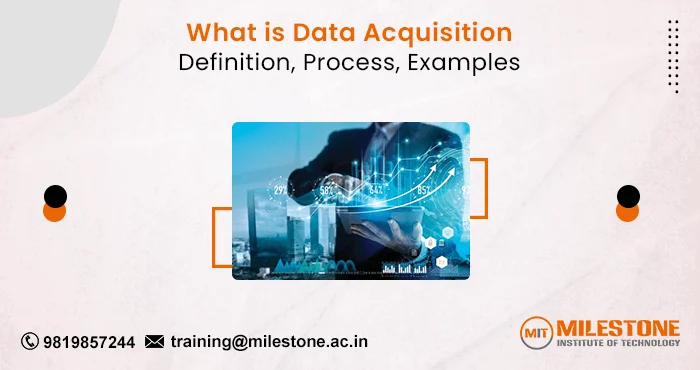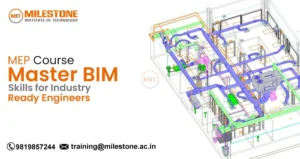In today’s data-driven world, the ability to gather and process data efficiently is paramount for businesses and researchers alike. The digital age has made vast amounts of data available at our fingertips, but the challenge lies in how to collect, process, and analyze this data effectively. Data Acquisition becomes essential in this situation. It is a fundamental step in any data-related project, from simple research studies to complex machine learning models. In this blog, we will delve into
what is data acquisition, by understanding its concepts, explore its significance, and discuss the tools and processes involved.
What is Data Acquisition?
Data acquisition refers to the process of collecting, measuring, and storing data from various sources. This data can come from a wide range of inputs, including physical sensors, databases, online sources, or manual inputs. The primary goal of data acquisition is to gather accurate and relevant data that can be analyzed to extract meaningful insights.
In simple terms, data acquisition is the first step in the data processing pipeline. It involves capturing raw data and converting it into a format that can be easily analyzed. This process is critical in various fields, including engineering, scientific research, healthcare, and business analytics.
Key Components of Data Acquisition
- Data Sources: These are the origins from which data is collected. Data sources can be physical sensors, online databases, social media platforms, or any other system that generates data.
- Data Collection Methods: Depending on the data source, different methods are used to collect data. For example, sensors might capture real-time environmental data, while web scraping tools might gather information from online sources.
- Data Storage: Data must be safely maintained/stored after it has been collected. This could involve databases, cloud storage, or other digital storage systems.
- Data Processing: Raw data is often unstructured and needs to be processed to remove noise and ensure consistency. Data preparation for analysis is done in this stage.
What is Data Acquisition in Machine Learning?
Data Acquisition is essential to the machine learning process in order to create accurate and dependable models. In order to identify patterns and provide predictions, machine learning algorithms require huge datasets. Without high-quality data, even the most sophisticated algorithms can produce poor results.
The Role of Data Acquisition in Machine Learning
- Training Data: Machine learning models are trained on datasets that contain examples of the problem they are intended to solve. Data acquisition ensures that the training data is representative of the real-world scenario the model will encounter.
- Data Quality: The quality of data directly impacts the performance of a machine learning model. Data acquisition processes must focus on gathering clean, accurate, and relevant data to avoid introducing biases or errors into the model.
- Data Diversity: For a machine learning model to generalize well, it needs diverse datasets for training. Data acquisition efforts should aim to collect data from a variety of sources to cover different scenarios and edge cases.
- Data Volume: Machine learning models often require large volumes of data to achieve high accuracy. Effective strategies can help gather sufficient data for robust model training.
Data Acquisition Process
The data acquisition process typically involves several steps, each designed to ensure that the collected data is accurate, relevant, and ready for analysis. Below is an overview of the key stages in the data acquisition process:
1. Identifying Data Sources
The first step in this process is identifying the sources from which data will be collected. These sources could be physical devices (like sensors), digital platforms (like social media), or existing databases. The project’s particular needs will determine the data sources used.
2. Data Collection
Next, we collect data after identifying the sources. One can use automatic or manual systems to achieve this task. In many cases, data collection involves capturing real-time data from sensors or scraping data from websites.
3. Data Preprocessing
Raw data is often messy and may contain errors or inconsistencies. Data preprocessing involves cleaning the data, removing duplicates, and transforming it into a structured format. This step is crucial to ensure that the data is suitable for analysis.
4. Data Storage
After preprocessing, the data should be in a secure location. Depending on the volume of data, this could be a database, a data warehouse, or cloud storage. Proper data storage is essential for maintaining data integrity and facilitating easy access for analysis.
5. Data Validation
Before analyzing the data, one must validate it to ensure accuracy and completeness. Data validation checks for any inconsistencies, missing values, or errors that may have been introduced during the collection or preprocessing stages.
6. Data Integration
In many cases, integrating data from multiple sources is necessary to create a comprehensive dataset. Data integration involves combining data from different sources and ensuring consistency across the dataset.
7. Data Analysis
After acquiring, preprocessing, and validating the data, it is ready for
data analysis. This step involves using statistical methods or machine learning algorithms to extract insights from the data.
Data Acquisition Tools
There are various tools and technologies available to facilitate the data acquisition process. These tools range from simple data collection software to advanced systems that automate the entire process. Below are some commonly used data acquisition tools:
1. LabVIEW
Many engineers and scientists use
LabVIEW, a popular data acquisition tool, in their research and projects. It allows users to create custom systems by connecting hardware devices, such as sensors, to a computer. Many people use LabVIEW to collect and analyze real-time data.
2. MATLAB
MATLAB is a powerful tool for data acquisition and analysis, particularly in engineering and scientific applications. It provides a range of functions for collecting data from various sources and processing it for analysis.
3. Apache NiFi
A data integration tool available as open-source software called Apache NiFi makes it easier to gather, process, and distribute data among many systems.In big data environments, organizations commonly use it to acquire data, collect large volumes of data, and process it in real-time.
4. AWS Data Pipeline
AWS Data Pipeline is a cloud-based tool that makes data acquisition more efficient. It allows users to define data workflows, including data collection, processing, and storage, and ensures that the data is available for analysis when needed.
5. Web Scraping Tools
Web scraping tools such as BeautifulSoup, Scrapy, and Selenium collect data from websites. These tools are particularly useful for gathering large datasets from online sources, such as social media platforms or e-commerce sites.
6. Custom APIs
Custom APIs (Application Programming Interfaces) are often developed to facilitate data acquisition from specific sources. For example, an organization might create an API to collect data from its internal systems and make it available for analysis.
Data Acquisition Examples
Data acquisition is use in a wide range of applications across different industries. Below are a few examples that illustrate the importance and versatility of this technique:
1. Healthcare Monitoring
Data Acquisition is essential to patient monitoring in the healthcare sector. Sensors monitor vital indicators such as blood pressure, oxygen saturation, and heart rate in real time. Healthcare providers quickly respond to potential health issues by processing and analyzing the data to detect any abnormalities.
2. Environmental Monitoring
Data acquisition is the means by which environmental monitoring systems gather data. Environmental monitoring systems use data collection to gather information on various environmental factors such as water levels, humidity, temperature, and air quality. In order to monitor environmental changes and make wise decisions on resource management and conservation, this data is important.
3. Manufacturing Process Control
For manufacturing, companies use data collection to monitor and oversee production processes. Sensors collect data on machine performance, product quality, and other key metrics. In real-time, data is analyse to optimize production efficiency and reduce waste.
4. Financial Market Analysis
Financial businesses employ data acquisition to collect and analyze market data, such as stock prices, trading volumes, and economic indicators. Utilizing this data helps investors make judgments about investments, trade methods, and market movements.
5. Scientific Research
In scientific research, acquisition is essential for collecting experimental insights or information. Researchers employ various tools and techniques to gather data from experiments, enabling them to analyze and test hypotheses, ultimately drawing conclusions.
Where to Learn Data Acquisition?
If you’re interested in learning more about data acquisition and developing the skills needed to excel in this data analytics field, we will suggest Milestone Institute of Technology. This institute offers a comprehensive curriculum covering all aspects of
data science and data analytics, from basic concepts to advanced techniques. Whether you’re a beginner or an experienced professional, the courses at Milestone Institute of Technology can help you master this most demanding skills.
Frequently Asked Questions
Which are the Primary Challenges in the Data Acquisition process?
Data acquisition can be challenging due to factors such as data quality, data integration, and the need for real-time processing. The data which is collect should be accurate, comprehensive, and consistent for a good analysis.
Additionally, integrating data from multiple sources and processing large volumes of data in real-time can be complex and require specialized tools and techniques.
How does data acquisition differ from data collection?
Although they commonly refer to various parts of the process, data collection and data acquisition are not synonymous. Data gets collect from several sources. In contrast, it encompasses the entire process, including data collection, preprocessing, storage, validation, and integration.
What industries rely heavily on data acquisition?
This process is vital in industries such as healthcare, manufacturing, environmental monitoring, finance, and scientific research. For these sectors to make educated decisions, streamline operations, and spur innovation, precise and timely data is essential.




